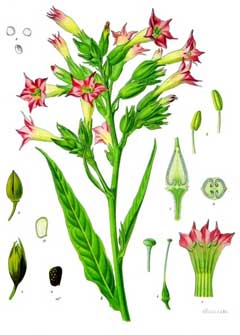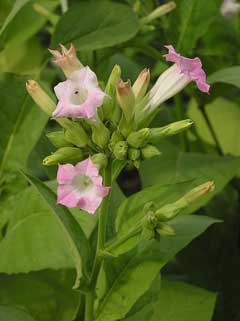 |
|
http://commons.wikimedia.org/wiki/File:Koeh-098.jpg |
 |
| http://commons.wikimedia.org/wiki/User:Jom |
Translate this page:
Summary
Physical Characteristics

 Nicotiana tabacum is a ANNUAL growing to 1.2 m (4ft).
Nicotiana tabacum is a ANNUAL growing to 1.2 m (4ft).
See above for USDA hardiness. It is hardy to UK zone 8 and is frost tender. It is in flower from July to September, and the seeds ripen from August to October. The species is hermaphrodite (has both male and female organs) and is pollinated by Bees, Lepidoptera (Moths & Butterflies).
It is noted for attracting wildlife.
Suitable for: light (sandy), medium (loamy) and heavy (clay) soils and prefers well-drained soil. Suitable pH: mildly acid, neutral and basic (mildly alkaline) soils. It cannot grow in the shade. It prefers moist soil.
UK Hardiness Map
US Hardiness Map
Synonyms
Plant Habitats
Cultivated Beds;
Edible Uses
Edible Parts: Leaves Oil
Edible Uses: Egg Oil
A protein can be extracted from the leaves. It is an odourless, tasteless white powder and can be added to cereal grains, vegetables, soft drinks and other foods[183]. It can be whipped like egg whites, liquefied or gelled and can take on the flavour and texture of a variety of foods[183]. It is 99.5% protein, contains no salt, fat or cholesterol[183]. It is currently (1991) being tested as a low calorie substitute for mayonnaise and whipped cream[183].
References More on Edible Uses
Medicinal Uses
Plants For A Future can not take any responsibility for any adverse effects from the use of plants. Always seek advice from a professional before using a plant medicinally.
Antispasmodic Diuretic Emetic Expectorant Homeopathy Irritant Narcotic Sedative
Sialagogue
Tobacco has a long history of use by medical herbalists as a relaxant, though since it is a highly additive drug it is seldom employed internally or externally at present[4, 254]. The leaves are antispasmodic, discutient, diuretic, emetic, expectorant, irritant, narcotic, sedative and sialagogue[4, 192, 213]. They are used externally in the treatment of rheumatic swelling, skin diseases and scorpion stings[240]. The plant should be used with great caution[4], when taken internally it is an addictive narcotic[222]. The active ingredients can also be absorbed through the skin[4]. Wet tobacco leaves can be applied to stings in order to relieve the pain[213]. They are also a certain cure for painful piles[4]. A homeopathic remedy is made from the dried leaves[232]. It is used in the treatment of nausea and travel sickness[232].
References More on Medicinal Uses
The Bookshop: Edible Plant Books
Our Latest books on Perennial Plants For Food Forests and Permaculture Gardens in paperback or digital formats.

Edible Tropical Plants
Food Forest Plants for Hotter Conditions: 250+ Plants For Tropical Food Forests & Permaculture Gardens.
More

Edible Temperate Plants
Plants for Your Food Forest: 500 Plants for Temperate Food Forests & Permaculture Gardens.
More

More Books
PFAF have eight books available in paperback and digital formats. Browse the shop for more information.
Shop Now
Other Uses
Insecticide Oil Repellent
All parts of the plant contain nicotine, this has been extracted and used as an insecticide[20, 37, 46]. The dried leaves can also be used, they remain effective for 6 months after drying[169]. The juice of the leaves can be rubbed on the body as an insect repellent[213]. The leaves have been dried and chewed as an intoxicant. The dried leaves are also used as snuff or smoked. This is the main species that is used to make cigarettes and cigars. A drying oil is obtained from the seed[57, 171]. Dynamic accumulator.
Special Uses
Attracts Wildlife Dynamic accumulator Scented Plants
References More on Other Uses
Cultivation details
Prefers a well-drained deep rich moist soil in a sunny position[1, 200]. Plants are not very hardy in Britain, but they can be grown as biennials in areas where winter temperatures do not fall below about -5°c[200]. A polymorphic species[50]. Tobacco is very widely cultivated for its leaves, there are many named varieties[183]. As well as being used as an insecticide, the leaves are used to make cigarettes, cigars, snuff and for chewing. There are many long-term health problems associated with these uses, especially from cancer, lung, circulatory and heart diseases. The plant accumulates potassium[18]. The plant has sweetly scented flowers that release most of their scent in the evening and attract moths[30]. Plant requires more than 14 hours daylight per day in order to induce flowering[169].
References Carbon Farming Information and Carbon Sequestration Information
Temperature Converter
Type a value in the Celsius field to convert the value to Fahrenheit:
Fahrenheit:
The PFAF Bookshop
Plants For A Future have a number of books available in paperback and digital form. Book titles include Edible Plants, Edible Perennials, Edible Trees,Edible Shrubs, Woodland Gardening, and Temperate Food Forest Plants. Our new book is Food Forest Plants For Hotter Conditions (Tropical and Sub-Tropical).
Shop Now
Plant Propagation
Seed - surface sow in a warm greenhouse about 10 weeks before the last expected spring frosts. The seed usually germinates in 10 - 20 days at 20°c. Keep the soil moist and pot up as soon as the plants are big enough to handle, planting them out after the last expected frosts.
Other Names
If available other names are mentioned here
Native Range
Coming Soon
Weed Potential
Right plant wrong place. We are currently updating this section.
Please note that a plant may be invasive in one area but may not in your area so it's worth checking.
Conservation Status
IUCN Red List of Threatened Plants Status :

Growth: S = slow M = medium F = fast. Soil: L = light (sandy) M = medium H = heavy (clay). pH: A = acid N = neutral B = basic (alkaline). Shade: F = full shade S = semi-shade N = no shade. Moisture: D = dry M = Moist We = wet Wa = water.
Now available:
Food Forest Plants for Mediterranean Conditions
350+ Perennial Plants For Mediterranean and Drier Food Forests and Permaculture Gardens.
[Paperback and eBook]
This is the third in Plants For A Future's series of plant guides for food forests tailored to
specific climate zones. Following volumes on temperate and tropical ecosystems, this book focuses
on species suited to Mediterranean conditions—regions with hot, dry summers and cool, wet winters,
often facing the added challenge of climate change.
Read More
Expert comment
Author
L.
Botanical References
200
Links / References
For a list of references used on this page please go here
Readers comment